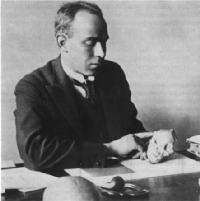Copyright © Jim Foley || Email me

 Raymond Arthur Dart was born in Queensland, Australia, in 1893, the fifth
of nine children to parents who lived on a bush farm raising cattle. He
won a scholarship to the University of Queensland in Brisbane where he
excelled, winning other prizes and scholarships and going on to do medical
studies at Sydney. After graduating, he went to England to serve in a
medical corps in World War I. As the war ended, he was delighted to be
accepted as an assistant by Grafton Elliot Smith, who worked at the
University of Manchester and was probably the world's preeminent
neuroanatomist (and a fellow Australian who was later knighted). Something
in the relationship may not have clicked, because in 1922 Dart was sent off
to be professor of anatomy at the newly-founded University of Witwatersrand
in Johannesburg, South Africa. Despite Dart's brilliance, he appears to
have had a reputation for "flightiness, unorthodoxy and a scorn for
accepted opinion". This was hardly a prime opportunity for one of Smith's
brightest students. Conditions at the university were appalling, and Dart
had to work hard to build the anatomy department from the ground up.
Raymond Arthur Dart was born in Queensland, Australia, in 1893, the fifth
of nine children to parents who lived on a bush farm raising cattle. He
won a scholarship to the University of Queensland in Brisbane where he
excelled, winning other prizes and scholarships and going on to do medical
studies at Sydney. After graduating, he went to England to serve in a
medical corps in World War I. As the war ended, he was delighted to be
accepted as an assistant by Grafton Elliot Smith, who worked at the
University of Manchester and was probably the world's preeminent
neuroanatomist (and a fellow Australian who was later knighted). Something
in the relationship may not have clicked, because in 1922 Dart was sent off
to be professor of anatomy at the newly-founded University of Witwatersrand
in Johannesburg, South Africa. Despite Dart's brilliance, he appears to
have had a reputation for "flightiness, unorthodoxy and a scorn for
accepted opinion". This was hardly a prime opportunity for one of Smith's
brightest students. Conditions at the university were appalling, and Dart
had to work hard to build the anatomy department from the ground up.
In 1924, Dart learned of a fossil baboon skull that had been found at a nearby limestone quarry at Taung, and asked to be sent any more bones or fossils that were found. The first two crates arrived in November of that year, and Dart found a fossil cast of the inside of a primate skull, which fitted into another lump of stone which possibly contained a face. It took Dart about a month to remove enough stone to reveal the face and jaw of a young fossil primate, which would be nicknamed the Taung baby. Dart considered the fossil intermediate between apes and humans, and quickly wrote a paper for Nature which described it and named it Australopithecus africanus (Southern ape from Africa). After an initial burst of praise, the scientific establishment in Britain rejected the Taung baby as an ape. At the time, Piltdown Man was widely accepted as a human ancestor, and Taung, with its apelike skull and humanlike teeth, seemed difficult to reconcile with Piltdown's human skull and apelike jaw. Virtually the only supporter of Dart was the Scottish doctor and paleontologist Robert Broom. Dart did travel to London in 1930 to try and win support for his Taung baby, but his find was overshadowed by the recently discovered Peking Man skull. Dart gave up fossil hunting for many years, concentrating instead on his work at the Witwatersrand anatomy department, where he served as Dean from 1925 to 1943.
In the late 1930s and early 1940s Broom found many more australopithecine fossils in South Africa, and in the late 1940s Dart's position was vindicated when many scientists finally accepted that australopithecines were hominids. In the mid-1940s, Dart once again tried looking for fossils, at the site of Makapansgat. He found a number of fossils which he named Australopithecus prometheus, in the mistaken belief that their blackened state indicated the use of fire (in Greek mythology, Prometheus was the Titan who gave humans fire). They are now placed in A. africanus. Dart, never one to shy away from extravagant claims, also concluded from his analysis of the site that these creatures had had what he called an "osteodontokeratic" (bone, tooth and horn) culture, and argued that they were savage hunters and bloodthirsty killers whose violent tendencies had left their mark in human behavior. The "killer ape" idea was popularized by writer Robert Ardrey in books such as African Genesis, and is the inspiration behind the opening scene of the movie 2001: A Space Odyssey. These claims were strongly criticized, and later study showed them to be wrong.
Dart lived to see the 60th anniversary of the discovery of the Taung child, and died in 1988 at the age of 95.
Trinkaus E. and Shipman P. (1992): The neandertals: changing the image of mankind. New York: Alfred E. Knopf.
Tattersall I. (1995): The fossil trail: how we know what we think we know about human evolution. Oxford,NY: Oxford University Press.
Wheelhouse F. (1983): Raymond Arthur Dart: a pictorial profile. Hornsby, Australia: Transpareon Press.
Raymond Dart,1893-1988, by Chrissy Duhn
Raymond Dart, with Dennis Craig (1959): Adventures with the Missing Link. (Raymond Dart's autobiography)
This page is part of the Fossil Hominids FAQ at the talk.origins Archive.
Home Page |
Species |
Fossils |
Creationism |
Reading |
References
Illustrations |
What's New |
Feedback |
Search |
Links |
Fiction
http://www.talkorigins.org/faqs/homs/rdart.html, 03/31/2002
Copyright © Jim Foley
|| Email me 